Water heating in a private house: rules, norms and organization options
The climatic conditions of the middle strip and the north of Eurasia require thermal insulation of houses, however, warming alone is not enough. Heat loss must be compensated for with a heating system. Water heating in a private house is a common and most effective way.
The quality of the heating circuit depends on the design features, the choice of heating device and the type of wiring. You will learn how to determine the equipment and the most suitable circuit by reading the article we have proposed. The information provided is based on the requirements of building codes.
We described in detail the principle of the device for a water heating system, and examined typical device options. To optimize the perception of a difficult topic, they applied schemes, photo collections and videos.
The content of the article:
Structure and principle of operation
Heating structures with a liquid coolant have a similar set of constituent parts, these are:
- heating equipment - boiler (gas, liquid or solid fuel), stove, fireplace.
- Closed loop in the form of a pipelineproviding continuous circulation of the heated and cooled heat carrier (antifreeze).
- Heating appliances - metal finned, panel or smooth-tube radiators, convectors, pipelines of water heated floors.
- Stop valvesrequired to disconnect individual devices or system lines for repair and maintenance;
- devices for adjusting and monitoring the operation of the system (expansion tank, pressure gauge, relief valves, etc.).
- Circulation pumpsused to create a forced supply of coolant, sometimes to ensure a stable pressure in the system, a booster pump is installed.
If a centralized gas main is nearby, the most economical solution is to install a gas boiler.
In the absence of central networks, an independent gas supply system will have to be installed. However, this option is applicable only in the case of equipping a estate of a sufficiently large area.
In cottages built on small plots in non-gasified areas, an autonomous operation of gas heating equipment will provide an ordinary cylinder. As an alternative, you can use liquid or solid fuel stoves, and only in extreme cases - expensive electrical devices.
Preference water heating in country houses give away thanks to the simple principle of operation. When heated in a boiler to a certain temperature, water under pressure is supplied to pipes leading to radiators or convectors.

According to the type of coolant movement along the heating circuits, they are divided into:
- Natural (gravitational). The circulation of the coolant in them is stimulated by natural phenomena, according to which the heated water rushes up, and after the heat is transferred to the radiators and cooled down, it returns down. There she again enters the boiler to resume cyclic movement.
- Artificial (they are also pumping or forced). The circulation pump is responsible for the circulation of the coolant in the forced circuits, which on one side of the circuit pumps the hot coolant, and on the other sucks the cooled water.
Gravity scheme is the simplest and most affordable option for independent implementation. It consists of a minimum of equipment. These are return and supply lines, a boiler, an open expansion tank, radiators. Because the movement of the coolant does not require pump stimulation, the systems are absolutely non-volatile.

To pluses natural heating it is worth attributing the insignificant construction costs compared to the pumping counterpart.They do not need to be equipped with sophisticated technical devices that are not cheap. During operation, there is no cost of electricity.
The weighty minus of gravitational systems is the extremely limited range. They can work at full strength with a horizontal length of up to 30 m. Such heating for a long time “accelerates” after a downtime. There is a risk of freezing of the coolant in an open tank during the frosty period.

Forced circulation is good because it freely handles multi-storey buildings with an extensive and extensive heating network. The scheme is more effective than the previous type, but more expensive and more complicated in construction. Before its construction, it is necessary to make competent calculations and develop a project.
Heating with artificial circulation it is equipped not only with pumps, but also with all kinds of technical devices for regulating heat transfer and monitoring the operation of the system. Among them are automatic and mechanical air ducts, temperature regulators, pressure gauges, safety valves for dumping excess coolant into the sewer, etc.

Compulsory heating equipment must be selected based on calculations. For example, for the movement of the heat carrier along each 10 m of the heating circuit, 0.6 m of pressure created by the pump is necessary. In order to choose the necessary device, you need to know exactly the length of the pipeline and the hydraulic resistance in all areas.
It often happens that for equipping artificial water heating of a country house, one pump is insufficient. Then an additional circulation analogue or booster pump is installed.
The main disadvantage of forced heating is dependent on continuous supply of electricity. In case of interruptions, it is recommended to stock up with a generator, which also does not differ in low price.

Standards and requirements for autonomous heating
Before designing a heating structure, you need to look at SNiP 2.04.05-91, which sets out the basic requirements for pipes, heating devices and valves.
General norms are reduced to ensure that the house has a comfortable microclimate for the people living in it, to properly equip the heating system, having previously compiled and approved the project.
Many requirements are formulated in the form of recommendations in SNiP 31-02, which governs the rules for the construction of single-family houses and providing them with communications.
The provisions related to temperature are separately specified:
- coolant parameters in pipes should not exceed + 90ºС;
- optimal indicators are within + 60-80ºС;
- the temperature of the outer surface of the heating appliances located in the direct access zone should not exceed 70ºС.
Heating system pipelines are recommended to be made of brass, copper, steel pipes. In the private sector, polymer and metal-plastic pipe products approved for use in construction are mainly used.

The method of laying a heating pipeline can be:
- Open. It involves laying on building structures with fastening with clips and clamps. Allowed with the device circuits of metal pipes. The use of polymer analogues is permitted if their damage from thermal or mechanical stress is excluded.
- Hidden. It involves laying pipelines in gates or channels selected in building structures, in skirting boards or behind protective and decorative screens. Monolithic contour is allowed in buildings designed for a minimum of 20 years of operation and with a pipe service life of at least 40 years.
The priority is an open installation method, because the design of the pipeline route should provide free access to any element of the system for repair or replacement.
Pipes are hidden in rare cases, only when such a solution is dictated by technological, hygienic or structural necessity, for example, when installing “warm floors” in a concrete screed.

At open gasket Highways sections crossing unheated rooms must be provided with thermal insulation corresponding to the climatic data of the construction region.
Autonomous heating pipelines with a natural type of circulation should be installed in the direction of movement of the coolant, so that the heated water reaches the batteries by gravity, and after cooling it moves along the return line to the boiler in the same way. Highways of pumping systems are built without a slope, because it is not necessary.
The use of various types is stipulated. expansion tanks:
- open, used for systems with both pumping and natural coercion, should be installed above the main riser;
- closed membrane devices used exclusively in forced systems are installed on the return line in front of the boiler.
Expansion tanks are designed to compensate for the thermal expansion of the liquid during heating. They are needed to dump surpluses into the sewers or corny on the street, as is the case with the simplest open options. Closed capsules are more practical, because they do not require human involvement in regulating the pressure of the system, but more expensive.

When choosing stop valves, ball valves are preferred, when choosing a pump installation, equipment with a pressure of up to 30 kPa and a capacity of up to 3.0 m3 / h is preferred.
The budget opening varieties must be periodically replenished due to standard weathering of the fluid. Under their installation, it is necessary to significantly strengthen the attic floor and insulate the attic.

Types of water heating systems
The type of heating system is determined by a combination of several factors. These include circulation of the coolant, the method of assembly of the system, the lower or upper version of the laying of the supply pipe, etc.
Regardless of the type of heating device, whether it is a traditional radiator, a plinth convector or a “underfloor heating coil”, heated water reaches them, and after cooling leaves the standard way for all systems.
Two-pipe and one-pipe designs
The ultimate object of heat transfer are appliances located in all heated areas of the house. In many respects, the heating efficiency depends on the installation scheme of the pipeline, so we will dwell on one- and two-pipe wiring.
The most common is a classification consisting of two points:
- Single tube version - serial connection of radiators. The bottom line is that the coolant entering the system sequentially flows from one device to another. On approaches to distant points, he manages to cool significantly.
- Two-pipe version - a system with parallel connection of the supply and return pipes. Its principle is based on the fact that the supply is carried out to all devices almost simultaneously. The cooled water does not flow into the next device, but is collected by the return line and transferred to the boiler.
Monotube schemes are available with both natural and forced water movement. Within their class, they are divided into two varieties: flowing and with bypass.
In flowing circuits, the coolant, upon reaching the extreme radiator, manages to cool down very much, so it is recommended to install devices with an increased number of sections in far rooms.
Implementation in bypass system allows you to partially redirect the hot fluid to the following devices, so almost all batteries receive and give off almost equal amounts of heat. The movement of heated water is controlled either by two valves installed on the bypass and the supply pipe, or by one three-way valve.
The main difference between two-pipe structures is the use of two branches: feed and return. The first serves to supply hot coolant to the radiators, the second - to divert water back to the boiler.

The two-pipe wiring diagram is used in systems with both types of coolant movement. According to the number of processed contours, it can be single and double circuit.
In the first case the boiler is installed at the beginning of the pipeline, and the pipes are routed to the left and to the right of the unit around the perimeter of the heated object. In the second case, the boiler is installed in the center, and the heating circuits are positioned so that their rings are on both sides of the unit.
The 2-pipe system is more functional and reliable, it allows you to evenly distribute heat throughout all rooms. Thanks to additional taps and adjustment devices, it is possible to control the heat supply to each individual radiator. If one element fails, the performance of the remaining devices will not be affected.

Variations on connecting pipes and devices
All of the listed types of water heating for arranging a country cottage are divided into subspecies:
- By the location of the riserscombining heating appliances. They are divided into horizontal and vertical. It is clear that the former are used in single-story buildings, the latter in multi-story buildings. In single-tube systems with natural movement, there are only feed risers.
- By the location of the supply and return pipes. There are upper or lower wiring. The first involves laying the feed at the highest points of the system, so that the coolant flows into the devices from above. According to the second situation, the return flow is laid below the radiators.
Gravity systems with lower wiring are rarely used because of the difficulties with air exhaust in distant instruments. The lower wiring is better combined with pump circulation, each device of which is still equipped with an air vent.

Heating with top wiring is arranged in cottages without basements, but with an attic. Occasionally, in the absence of an attic, the supply is laid along the interface line between the ceiling and the walls, which negatively affects the interior picture. The lower layout is suitable for houses with a flat roof without roofs, but with a basement.
Pipeline assembly method
Classification by the method of pipeline construction divides heating systems into tee, collector and combined.
Tee schemes can be safely attributed to the classics of the genre. They involve assembling pipelines and connecting devices to them with the help of tees used in nodes connecting pipes to risers, radiators to pipes, etc. Fundamentally, this is a sequential circuit.
Collector or otherwise beam structure increases the possibilities of water heating of the cottage. This is a kind of modified system with individual branches (rays) of the pipeline extended to each device and with a distribution element in the center.
Distribution unit - the collector is equipped with many taps, so that you can control the heat transfer of each device individually, turn it off for repair. If desired and financial capabilities, each branch can be equipped with its own pumping device.

The collector wiring is arranged mainly for horizontal circuits with a lower gasket of the supply pipe. When installing in 2- and 3-story houses, it is recommended to install a distribution manifold on each floor - this way you can adjust the air temperature in any corner of the building.
The adjustment unit for cottages on several floors consists of two interconnected nodes: a feed collector and an analog for return. The first is responsible for the delivery of hot coolant to the devices, the second stimulates the removal of cooled liquid.

Collector wiring is arranged on the basis of one- and two-pipe heating systems, used in combination with a perimeter (tee).
Features of baseboard heating
Radiators or batteries in the traditional sense are not the only heating devices to create a comfortable microclimate in individual rooms. Appeared not so long ago “Warm skirting boards” - heating elements, in their shape and location resembling the building analogues of the same name.

The principle of operation of the device, located around the perimeter, helps to maintain a given temperature constantly. First, the tubes inside the casing are heated, then - the ducts, from it warm air rises, increasing the temperature of the walls.
Thus, the air in the room is heated directly from the baseboards and from all the walls along which they are located.

Advantages of baseboard heating:
- creating a comfortable microclimate that excludes active air circulation;
- the possibility of warming risk zones at the joints of the floor and walls, where mold often appears;
- simple installation, which can be performed without the involvement of specialists;
- choice of modules by type (single and double row) and power (for example, 310 W and 510 W);
- diverse design that does not require camouflage;
- affordable price.
The disadvantages include special arrangement conditions: furniture items cannot be placed along horizontal elements, as this will harm the heat transfer process. Each circuit included in the system should not be longer than 15 meters, therefore, for a large room, installation of 2 or 3 circuits is required (as an option - combined heating).

In addition to water skirting boards, electric ones are used, but their maintenance for a private house is too expensive.
The equipment of the "Warm floor" system
Efficient and inexpensive design, referred to as floor heating, which produces space heating on the floor side, has long established itself only on the best side. It is actively used in urban apartments to create a comfortable atmosphere in bathrooms, bathrooms, in bedrooms, in kitchens and loggias.

The pipeline must have high thermal conductivity, strength, elasticity, minimal resistance, therefore, metal plastic or sewn polyethylene is used for its manufacture. A protective and stabilizing coating is a cement screed.
Advantages of underfloor heating:
- efficiency with any type of flooring (laminate, linoleum, carpet, ceramic tile);
- noticeable heat savings - from 30% to 50%;
- inexpensive cost and installation;
- the ability to do it yourself;
- use in combined heating systems (along with radiators and convectors).
Autonomous water heating does not depend on the supply of electrical energy, as it is powered by a gas (or other) boiler.

Disadvantages water heated floors can be attributed to the imperfection of regulation and the inability to install in the city with centralized heating, but this does not apply to local suburban systems. In case of violation of the installation rules, an emergency and flooding is possible, so you should carefully consider both the choice of equipment and installation.
Read more about the coolant and its properties
There is no perfect fluid for any heating system. Each of the options presented on the heat transfer market has specific characteristics, for example, a range of operating temperatures.
If you violate the boundaries of the specified range, the heating system will simply “stand up”, and with a worse outcome, pipes will burst and expensive equipment will fail.
In addition to temperature parameters, pipeline fluid possesses such properties as viscosity, anticorrosion, ability to release toxic substances. An analysis of the required qualities showed that the best liquid coolants are purified water and a special chemical solution - antifreeze.

Filling with antifreeze is necessary in homes that are not a permanent residence. Usually leaving the building in the cold season, the owners drain the water to avoid an accident and equipment breakdown. You do not need to remove antifreeze - upon returning you can immediately turn on the boiler without fear of leakage or rupture.
At extreme temperatures, the chemical coolant, having changed its structure, retains its previous dimensions. Simply put, it turns into a gel that retains its properties without change. When the temperature reaches a comfortable mark, the gel-like structure again becomes liquid, completely retaining its original volume.
Some more useful information about antifreeze:
- serves at least 5 years, one filling is able to withstand 10 heating seasons;
- the fluidity is 2 times higher than that of water, therefore, it is required to monitor the tightness of the joints;
- increased viscosity requires insertion of a more powerful circulation pump;
- expansion ability during heating entails the installation of a volumetric expansion tank.
And you must always remember that the chemical solution is toxic and dangerous to human health.

Despite the outstanding characteristics of antifreeze, water as a coolant is more popular. It has the highest possible heat capacity, which is approximately 1 kcal.This means that a coolant heated to 75 ° C when cooling in a radiator to 60 ° C will give the room about 15 kcal of heat.
Water is available. If you equip the water supply system with reliable filters, you can use the free option - water from your own well. It does not contain hazardous chemicals and will not cause poisoning in an accident.
The negative side of water is the content of certain mineral salts that cause corrosion. The problem is solved by simple boiling or using rain (or melt) instead of well water.

Water is not recommended for use in homes for periodic residence.
Pipe selection for routing
The final result depends on the quality of each system part, which consists in preserving and saving heat, therefore, the most extended elements - pipes - must also be given some attention.
From a technological point of view pipes and fittings must possess the following qualities:
- strength;
- ease;
- suitability for repair;
- tightness;
- low noise.
Low cost is also an important component when choosing, because a large number of products for various purposes are required for heating system equipment.

Now hardly anyone will undertake the installation of wiring from metal pipes. Steel, copper and galvanized products are a thing of the past, giving way to cheaper and more functional counterparts.
The best alternative is polymer products. which can be divided into three groups:
- polypropylene;
- metal-plastic.
pros polypropylene pipes - low cost, ease of welding, long service life. Minus - lack of elasticity. When replacing the pipe, you will have to change the whole fragment from connection to connection.

Durable plastic pipes resistant to sudden changes in temperature. Able to serve without major repairs up to 30 years. The weak point is the connecting elements - fittings with an unreasonably narrowed bore. If the coolant freezes, a breakthrough is likely.
When choosing pipes, focus on the main technical indicators of the equipment and the type of coolant.
Conclusions and useful video on the topic
Interesting videos provide useful information on schemes, components, installation of liquid heating systems, as well as on personal installation experience.
Video # 1. Features of a one-pipe heating system:
Video # 2. Overview of the schemes of a two-pipe heating system:
Video # 3. Practical application of the radiation scheme:
Video # 4. Detailed installation instructions for the heating system:
Advice to anyone who wants to independently equip a complex heating system in a country house: when designing a project, be sure to consult a specialist so that after installation you do not encounter unforeseen circumstances. Plumbers will help you choose reliable equipment, tell you a more efficient wiring diagram, make accurate calculations, and the result will be comfort and warmth in the house.
Do you have any questions about our proposed information? Want to share useful information or your own experience in the design of the heating circuit? Please write comments in the block below.


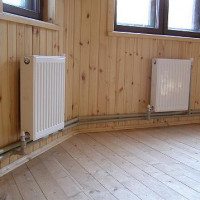 Steam heating in a private house and in a country house based on a stove or boiler
Steam heating in a private house and in a country house based on a stove or boiler 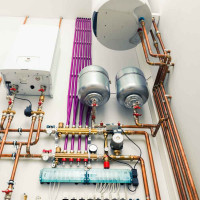 Do-it-yourself water heating: all about water heating systems
Do-it-yourself water heating: all about water heating systems 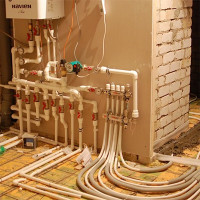 Optimal wiring of heating in a private house: a comparison of all typical schemes
Optimal wiring of heating in a private house: a comparison of all typical schemes 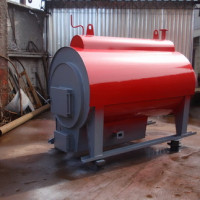 How to make steam heating yourself: device, rules and requirements
How to make steam heating yourself: device, rules and requirements 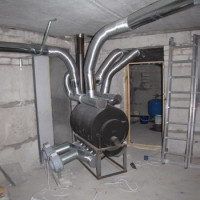 How to arrange air heating of a country house: rules and schemes of construction
How to arrange air heating of a country house: rules and schemes of construction 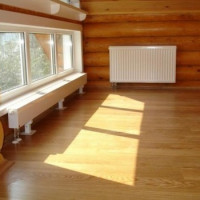 Heating in a wooden house: a comparative overview of suitable systems for a wooden house
Heating in a wooden house: a comparative overview of suitable systems for a wooden house  How much does it cost to connect gas to a private house: the price of organizing gas supply
How much does it cost to connect gas to a private house: the price of organizing gas supply  The best washing machines with dryer: model rating and customer tips
The best washing machines with dryer: model rating and customer tips  What is the color temperature of light and the nuances of choosing the temperature of the lamps to suit your needs
What is the color temperature of light and the nuances of choosing the temperature of the lamps to suit your needs  Replacement of a geyser in an apartment: replacement paperwork + basic norms and requirements
Replacement of a geyser in an apartment: replacement paperwork + basic norms and requirements
We have a gas boiler in our house, which heats the water and supplies heat to all rooms. Only the farthest rooms are the coldest there. We have to supply more gas to warm those rooms, respectively, more energy consumption. Now we’re thinking how to remodel the heating in the house so that all rooms warm up evenly and the energy consumption is not too big.
My wife and I thought about the device at the cottage of water heating. I personally did not particularly understand this topic. Following the link, I came across a topic that interests me. There was more than enough information, and it was set out in a fairly understandable language. The video in the end was especially helpful. Having studied the article, I found answers to many questions that interest me. Now I think that you can begin to deal with this issue without fear of being a layman.